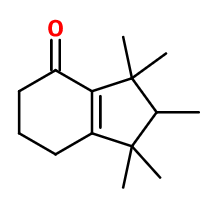Cashmeran®
Synthétique
Woody > Fresh Woods > Earthy > Camphoric > Musky

Crédits photo: ScenTree SAS
Other names :
1,1,2,3,3-pentamethyl-2,5,6,7-tetrahydroinden-4-one ; Astromeran ; Cas musc ; Cashmeran velvet ; 6,7- dihydro-1,1,2,3,3-pentamethyl-4(5H)-indanone ; Dihydropentamethyl indanone ; 1,2,3,5,6,7- hexahydro-1,1,2,3,3-pentamethyl-4H-inden-4-one ; Indomuscone ; Ianmeran ; Musk indanone
Volatility :
Heart/Base
Uses in perfumery :
Cashmeran® is used in woody, spicy, coniferous and ambery notes. Often associated with Kephalis®, and more generally with woody-ambergris and tobacco notes.
Natural availability :
Cashmeran® is not available in its natural state.
Year of discovery :
Cashmeran® was discovered by scientist John Hall in 1969. At the time, he was working on low cost transformations starting with molecule structures such as pentamethylindane and tetramethylnaphthalène.
Patent n°3,773,836 (US) published on Aug.18, 1969 by Hall.J for IFF
Other comments :
Cashmeran® has a very singular and complex smell, which differenciates it from any other molecule use din perfumes.
Price Range :
€€€
Stability :
Stable in perfumes and diverse functional bases

Crédits photo: ScenTree SAS
- Molecular formula :
- C14H22O
- Molecular Weight :
- 206,32 g/mol
- Density :
- 0,96
- Flash Point :
- 94°C
- Fusion Point :
- 27°C
- Appearance :
- Colorless liquid that crystallizes at room temperature
- Log P :
- 4,5
- Boiling Point :
- 285°C
- Detection Threshold :
- 1,2 ng/L air
Synthesis route :
One of the methods for synthesizing Cashmeran® is to oxidize pentamethyl tetrahydroindene in the presence of a cobalt naphthenate catalyst.
Synthesis precursor :
Cashmeran® is not a precursor to the synthesis of another compound of olfactory interest.
Isomerism :
Cashmeran® has an asymmetric carbon. It is nevertheless the racemic mixture of this molecule that is used in perfumery.
Alpha-Irone and Isoraldeine® are constitutional isomers of Cashmeran®. However, they have a violet and orris smell, different from Cashmeran®.
- EINECS number :
- 251-649-3
- FEMA number :
- Donnée indisponible.
- JECFA number :
- Donnée indisponible.
- FLAVIS number :
- Donnée indisponible.
- Allergens :
- This ingredient does not contain any allergen.
- IFRA :
- This ingredient is restricted by IFRA
- Restriction type :
- RESTRICTION
- Cause of restriction :
- DERMAL SENSITIZATION AND SYSTEMIC TOXICITY
- Amendment :
- 49
- Quantitative limit on the use :
-
Cat.1 Cat.2 Cat.3 Cat.4 Cat.5A Cat.5B Cat.5C Cat.5D Cat.6 0,0063 % 0,26 % 0,019 % 3,8 % 0,31 % 0,025 % 0,038 % 0,0084 % 0,0063 % Cat.7A Cat.7B Cat.8 Cat.9 Cat.10A Cat.10B Cat.11A Cat.11B Cat.12 0,031 % 0,031 % 0,0084 % 0,13 % 0,13 % 0,28 % 0,0084 % 0,0084 % 9,4 % - Restriction type :
- RESTRICTION QRA
- Cause of restriction :
- DERMAL SENSITIZATION
- Amendment :
- 48
- Quantitative usage limits :
-
Cat.1 Cat.2 Cat.3 Cat.4 Cat.5 Cat.6 Cat.7 Cat.8 Cat.9 Cat.10 Cat.11 0,34 % 0,44 % 1,81 % 5,43 % 2,86 % 8,7 % 0,91 % 2 % 5 % 2,5 % Not Restricted
To learn more about IFRA's standards : https://ifrafragrance.org/safe-use/library
ScenTree is solely responsible for the information provided here.

